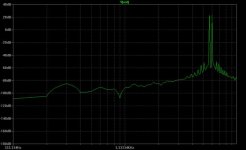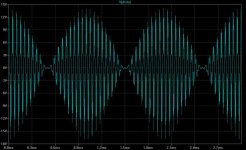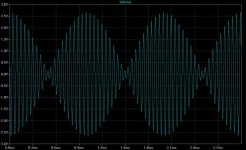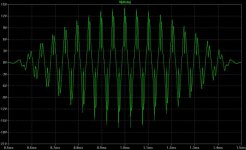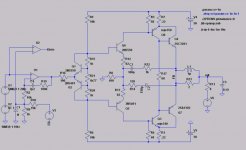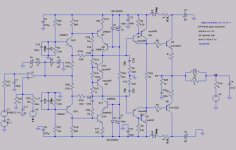There is a lot of arguments re NFB being a good thing or a bad thing.
Some vote against it, some vote for it.
To be able to define if a given amp is good or bad due to the use or not of NFB one must to know the amp's open loop distortion and decide if NFB is 'icing on the cake' or is used to straighten the bent donkey's leg.
Below we have a CCIR (19k & 20kHz) 80Vpp in 8 ohms trace of a simulated amp.
Just by this trace, this amp could be classified as a decent one (all other parameters, such as freq response, stability, etc are good).
Some vote against it, some vote for it.
To be able to define if a given amp is good or bad due to the use or not of NFB one must to know the amp's open loop distortion and decide if NFB is 'icing on the cake' or is used to straighten the bent donkey's leg.
Below we have a CCIR (19k & 20kHz) 80Vpp in 8 ohms trace of a simulated amp.
Just by this trace, this amp could be classified as a decent one (all other parameters, such as freq response, stability, etc are good).
Attachments
Bad, no doubt about it. You can prove it easily: Measure distortion with PSU attached, then measure again without power... all distortion gone!darkfenriz said:Is power supply a good thing or a bad thing...?
mzzj
Both have about the same NFB factor - between 55 and 60 dB at 20K (so they are of the high NFB type)
DSP_Geek
Both amps have the same input, output voltages.
The distortion traces scale have been multiplied by 1000 just to make it easier to compare.
The distorted waveshape is larger just because OL distortion is higher, but full of spikes, this being the main point here.
Here's the circuit of the 'bad' amp (the generators are used for the many simulations I've done - loop gain, FR, input disto, output disto, stabilty).
Both have about the same NFB factor - between 55 and 60 dB at 20K (so they are of the high NFB type)
DSP_Geek
Both amps have the same input, output voltages.
The distortion traces scale have been multiplied by 1000 just to make it easier to compare.
The distorted waveshape is larger just because OL distortion is higher, but full of spikes, this being the main point here.
Here's the circuit of the 'bad' amp (the generators are used for the many simulations I've done - loop gain, FR, input disto, output disto, stabilty).
Attachments
Re: Re: NFB - good, bad?
Mike, just plain flat good, independent of phase margin, undelining circuit, etc?
You're joking!
mikeks said:
Good.
Mike, just plain flat good, independent of phase margin, undelining circuit, etc?
You're joking!
Mr Evil said:
Bad, no doubt about it. You can prove it easily: Measure distortion with PSU attached, then measure again without power... all distortion gone!
Right. That's why in the 'good' amp I've taken precautions to keep PSRR better than 100dB (the inductors in the power lines, for example) over the whole audio range.
But PS effects were not taken in account in the above distortion traces.
In my view, the question isn't well defined so that answer is quite easy: it depends.
NFB is nothing but a tool. there aren't good or bad tools but good or bad craftsmen.
Foundamentally, we will never be able to produce real circuits exactly the same, or use top notch components / systems regardless of their costs. As such, there is always going to be a need to use the least expensive / lowest performance parts to produce the most manufacturable and highest performing systems.
NFB, in my view, does two key things: 1) it improves system performance; and 2) it produces consistent system performance in spite of wide variances of components going into the systems.
So you cannot design a system that doesn't have negative feedback (even in digital systems), principle #1.
Principle #2: you better learn how to use (not abuse) NFB wisely.
NFB is nothing but a tool. there aren't good or bad tools but good or bad craftsmen.
Foundamentally, we will never be able to produce real circuits exactly the same, or use top notch components / systems regardless of their costs. As such, there is always going to be a need to use the least expensive / lowest performance parts to produce the most manufacturable and highest performing systems.
NFB, in my view, does two key things: 1) it improves system performance; and 2) it produces consistent system performance in spite of wide variances of components going into the systems.
So you cannot design a system that doesn't have negative feedback (even in digital systems), principle #1.
Principle #2: you better learn how to use (not abuse) NFB wisely.
tlf9999
Yes, maybe I did not make the point clear enough.
It was not a poll type - just vote yes or no, but to show that it's perfectly possible for someone to say a given amp uses FB and sounds worse than a FB less amp..
And then, as it has happened countless times in audio, deduct that the culprit was NFB.
Without taking in account all the parameters involved.
Yes, maybe I did not make the point clear enough.
It was not a poll type - just vote yes or no, but to show that it's perfectly possible for someone to say a given amp uses FB and sounds worse than a FB less amp..
And then, as it has happened countless times in audio, deduct that the culprit was NFB.
Without taking in account all the parameters involved.
Re: tlf9999
You are right on: it is quite possible to worsen an amp's performance with NFB, and without NFB, and it is equally possible to improve an amp's performance with or without NFB. Those who concluded blindly that NFB is bad simply haven't figured out a way to use NFB to their advantage.
Jorge said:It was not a poll type - just vote yes or no, but to show that it's perfectly possible for someone to say a given amp uses FB and sounds worse than a FB less amp..
And then, as it has happened countless times in audio, deduct that the culprit was NFB.
Without taking in account all the parameters involved.
You are right on: it is quite possible to worsen an amp's performance with NFB, and without NFB, and it is equally possible to improve an amp's performance with or without NFB. Those who concluded blindly that NFB is bad simply haven't figured out a way to use NFB to their advantage.
Hello, Greg
And by then there wasn't any power supply ripple!
Hello, Andy
I seee you're not aware of one of the oldest tricks in audio.
Just apply some oil to the wiring/components. This way, electrons will move faster and NFB delay will be avoided. Why do you think oil caps sound better?

And by then there wasn't any power supply ripple!
Hello, Andy
I seee you're not aware of one of the oldest tricks in audio.
Just apply some oil to the wiring/components. This way, electrons will move faster and NFB delay will be avoided. Why do you think oil caps sound better?
- Status
- This old topic is closed. If you want to reopen this topic, contact a moderator using the "Report Post" button.
- Home
- Amplifiers
- Solid State
- NFB - good, bad?
